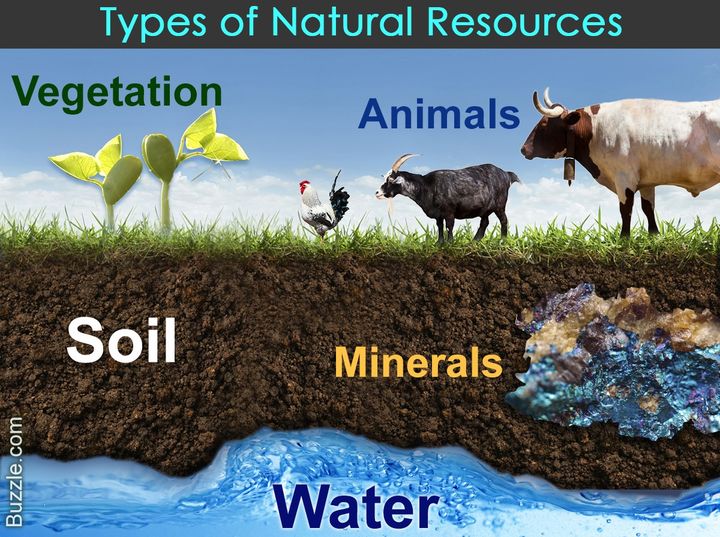According to Wikipedia, “Natural resources are resources that exist without actions of humankind. This includes all valued characteristics such as magnetic, gravitational, and electrical properties and forces. On earth, it includes sunlight, atmosphere, water, land along with all vegetation and animal life that naturally subsists upon or within the heretofore identified characteristics and substances.”
Natural resources can be defined as those resources that occur within the environment in their original and natural form, undisturbed by humanity. They take years to form without the intervention of humans.
Mother Earth is abundant with natural resources that develop on this planet using its surrounding environment. Thus the natural resources are mostly derived from the environment. While a few of them are used for our survival like water, and air, the rest of them like coal, gas, and oil is used for satisfying our daily needs.
From forests to mountains, to minerals, to coastal shores, and wetlands, each of these natural resources has its own importance. One of the issues that come up when trying to discuss ways of practicing energy conservation is that many people aren’t even aware of what the top 10 natural resources are that they are trying to conserve. Needless to say that everyone can name coal, gas, and oil – but what about the others?
With the world’s population fast approaching almost 8 billion, the issue becomes one of resource management as well. It is one thing to practice conservation, but we must understand that as the population grows, the demand grows as well.
Another problem is that as 3rd world countries continue to progress in industrialization, their need for resources is going to increase. It isn’t just that you can plan for an increase in need according to an increase in the percentage of use per billion persons; as societies grow and become more modernized, their reasonable use of natural resources also increases in proportion to people and industry.
It seems the most logical thing in the world to believe that the natural resources of the Earth, upon which the race depends for food, clothing, and shelter, should be owned collectively by the race instead of being the private property of a few social parasites. READ: Environmental Factors Affecting Health
Types of Natural Resources
- Classification on the basis of Origin
Biotic: Biotic resources come from the biosphere (living and organic material). Examples – forests and animals, and the materials that can be obtained from them. As fossil fuels such as coal and petroleum are formed from decayed organic matter, they are also included in this category.
Abiotic: Abiotic resources come from non-living, non-organic material. Examples – land, fresh water, air, rare-earth elements, and heavy metals including ores, such as gold, iron, copper, silver, etc.
- Classification on the basis of the Stage of Development of Natural Resources
Potential resources: Potential resources are those that can be used in the future. For example – petroleum in sedimentary rocks until drilled out and put to use remains a potential resource.
Actual resources: Resources that have been surveyed, quantified, and qualified and are currently in use. Examples – wood processing, which depends on technology and cost.
Reserve resources: Forming part of an actual resource that can be developed in the future.
Stock resources: Resources that have been surveyed, but due to lack of technology, cannot be put to use. Example – hydrogen.
- Classification on the basis of Recovery Rate
Renewable resources: Resources that can be replenished naturally are renewable resources. The resources, like wind, sunlight, air, water, etc. are abundantly available and their quantities are hardly get affected by human consumption. From a human use perspective, resources are said to be renewable as long as the rate of replenishment/recovery exceeds the rate of consumption. They replenish easily compared to non-renewable resources.
Non-renewable resources: Non-renewable resources either do not naturally form in the environment or form slowly. Minerals, the most common resource, fall in this category. From the human perspective, the rate of consumption of non-renewable resources exceeds the rate of replenishment/recovery. For example – fossil fuels, the rate of formation of fossil fuels is extremely slow (potentially millions of years).
Some resources naturally deplete without human interference, such as the radioactive element uranium which naturally decays into heavy metals. Out of these, the metallic minerals are the ones that can be reused through recycling. However, coal and petroleum cannot be recycled. These resources take millions of years to replenish once they are fully used.
Difference between Renewable and Non-Renewable Resources
| Renewable resource | Non-renewable resource |
| It can be renewed as it is available in infinite quantity | Once completely consumed, it cannot be renewed due to limited stock |
| Sustainable in nature | Exhaustible in nature |
| Low cost and environment-friendly | High cost and less environment-friendly |
| Replenish quickly | Replenish slowly or do not replenish naturally at all |
The 5 Most Important Natural Resources are:
- Air: Clean air is important for all plants, animals, and humans to survive on this planet. So, it is necessary to take measures to reduce air pollution.
- Water:70% of the Earth is covered in water and only 2 % of that is freshwater. Initiatives to educate and regulate the use of water should be taken.
- Soil: Soil is composed of various particles and nutrients. It helps plants grow.
- Iron: It is made from silica and is used to build strong weapons, transportation, and buildings
- Forests: As the population increases, the demand for housing and construction projects also increases. Forests provide clean air and preserve the ecology of the world.
FAQs
- What are the key natural resources?
Ans: Distribution of the world’s most important natural resources. Other resources include mineral resources such as copper, gold, and diamonds, energy resources such as gas, oil, and uranium, as well as agricultural and logging land resources. - What are the uses of natural resources?
Ans: Minerals, forest products, water, and soil are just a few of the natural resources that human beings use to produce energy and make use of things. Within a few years or decades, certain natural resources can be replicated. These are referred to as renewable resources. - How do humans depend on natural resources?
Ans: Living things need the land’s water, air, and energy, and they live in places with the things they need. For all they do, humans use natural resources. - What are the characteristics of natural resources?
Ans: On Earth, it requires sunshine, air, water, land (including all minerals) along with all the plants, crops, and animal life that live naturally on or within the characteristics and substances previously identified. - Does recycling save natural resources?
Ans: By sustainability, recycling also saves energy and natural resources. We can save natural resources by using materials more than once. Recycling saves trees and water in the case of paper. Growing up to 17 trees saves up to one ton of paper from recycled stock and uses 50 percent less energy.
How to Conserve Natural Resources
Preservation of the natural environment is essential for maintaining community sustainability. Water pollution affects your well water and living things around your home that rely on clean water to survive. You can take simple steps around the house that will help protect the water resources for you and your community.
Plant a Rain Garden
Directing downspouts and sump pump discharges to areas planted with water-loving plants, called rain gardens, helps water filter through the soil and recharges groundwater. University of Maine Cooperative Extension has a very good fact sheet online about installing rain gardens; click here to view it.
Mow High
Mowing your lawn higher than 3 inches will produce a lush turf that holds water, is weed-resistant, and requires less fertilizer.
Minimize Erosion
Maintain lush native plant growth in areas with steep slopes to hold soil in place. When you seed areas, use a straw mulch to minimize erosion.
Manage Stormwater Runoff
Slope driveways and patios to direct rainwater and snow melt to vegetated areas that recharge groundwater. When planning for additions or renovations, be sure to leave plenty of room to direct stormwater.
Landscape with Native Plants
Planting native plants reduce the need for chemical pesticides and fertilizers because these plants are well suited for the environment of Hampton Falls. Furthermore, native plants provide food and habitat for many wildlife species. Hardy native plants include white pine, arrowwood viburnum, and winterberry.
Minimize Impervious Surfaces
Build the smallest buildings, patios, and driveways possible and use water-permeable materials when you can.
Reduce Fertilizer Use
Grow and maintain plants that require no fertilization. Reduce lawn area and use only slow-release fertilizers.
Maintain Your Septic System
Environmental health agencies recommend that septic systems be inspected annually and pumped every three to five years. Never send grease, toxic chemicals, pharmaceuticals, or nonbiodegradable materials down the drain. These materials cause can thousands of dollars worth of damage.
Maintain Healthy Buffers to Wetlands
Maintaining 100 feet of lush, vegetated areas adjacent to wetlands will filter stormwater runoff, reduce erosion, lessen impacts of flooding, and provide adequate habitat for many wildlife species.






